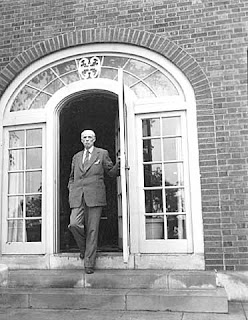Organ music (like Bach's "D-Minor Toccata and Fugue") has been often used for spooky effect in film and on radio. One of the best known examples is the phantom playing the organ in "The Phantom of the Opera."
Claude Rains playing the organ in the 1943 version of "The Phantom of the Opera"
Of course, in that story, the phantom is not actually a phantom, but a live person. I've heard, however, of a real organ-playing ghost in an old Minneapolis church.
Joyce Memorial Methodist Church (cum Joyce United Methodist Church) sits on the corner of Fremont Avenue and W. 31st Street in South Minneapolis. Built in 1907, it was named after a Methodist Episcopal bishop who died in 1905. In 2020 the church, no longer used as a place of worship, was designated a local landmark. Designed by architects Harry Downs and Harold Eads, the California Mission Revival style church looks somewhat out of place in this snowy northern city.
Joyce Memorial Methodist in 1953
Back in the 1980s when the building was still being used as a church, one of my neighbors, a member of the congregation, passed on to me stories that the custodian and members of the church council had told her.
One night as the custodian was alone in the church, working in the basement, he was startled to hear organ music burst from the sanctuary. He doubted that it could be mischievous kids because the instrument was being played with great skill and confidence.
He couldn't imagine who had gotten into the sanctuary without his knowledge, so he bounded upstairs to find out. The instant his hand touched the door to the sanctuary, the music stopped dead. The empty church was in darkness; all was still. The puzzled custodian flipped on the lights and went to check the organ console. It was closed and locked. No one could have had the time to turn it off, lock it, and leave the sanctuary in the few seconds between when he opened the door and turned on the lights. A few months later, the same thing occurred. The custodian heard similar bold, vigorous organ music pouring from the sanctuary, which was locked, dark, and deserted.
He wasn't the only one who heard the music. Several parishioners had also reported hearing pipe organ music from the street as they were leaving the church after a meeting at night. The sanctuary was in total darkness at the time.
My neighbor and other older parishioners speculated that the phantom organist was the clergyman the church was named in honor of, Bishop Isaac Wilson Joyce. They said that Joyce was renowned as a superb organist, although music remained an avocation throughout his life. He had the hymn "No, Not One" from the 1896 Methodist hymnal translated into Chinese and Japanese in an apparent evangelical effort.
No one knows for sure who the ghost was who played the Joyce Church organ, but the story passed on by the church elders fits as well as any.
Click for the piano version of "No, Not One!":
Piano version, "There’s not a friend like the lowly Jesus. No, not one"







No comments:
Post a Comment